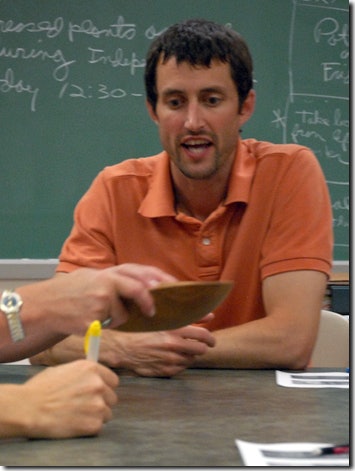 George Ironstrack is assistant director at Miami University’s Myaamia Center, which helps the Miami Tribe of Oklahoma with their research needs.
George Ironstrack is assistant director at Miami University’s Myaamia Center, which helps the Miami Tribe of Oklahoma with their research needs.CINCINNATI – A southwestern Ohio university is working to preserve 19th century land grant documents recently recovered by the Miami Tribe of Oklahoma that mark the tribe’s transition from collectively-held land to individual ownership as it tried—and mostly failed—to avoid government relocation.
Miami University’s preservation work on the eight land grants—one signed in 1823 by President James Monroe and seven signed in 1843 by President John Tyler—stems from a long collaborative relationship between the tribe and university. That relationship led to the creation several years ago of the university’s Myaamia Center, which helps the tribe with research needs.
Tribe member George Ironstrack, the center’s assistant director, says the grants found in storage at a Catholic diocese in Indiana are historically important because they show tribe members trying to secure a land base for their families. He says the grants were promised in treaties that increasingly required the tribe to give up large amounts of land sought by the government and others.
“Tribe members thought the grants might help them avoid relocation, but they ended up fracturing the tribal economy,” said Ironstrack, a descendant of Jean Baptiste Richardville, the chief who received the 1823 grant.
Individual parcels of land were much more vulnerable to being sold or seized by local governments for nonpayment of taxes, while tribal land was not taxed, Ironstrack said. Many families could not hold onto the land because of legal hurdles—some legitimate and some not—and ideological differences with local governments.
David Chang, a professor of history and American Indian studies at the University of Minnesota, says the Miami tribe and others had few options due to treaties and increasing pressure from those who wanted their land.
“They were in a tight spot and cornered, with each treaty forcing them to give up even more land,” Chang said.
The original grants are written on vellum or parchment, said Elizabeth Brice, Miami’s assistant dean for special collections. The 1823 grant is the most elaborate, with gilt edging and a ribbon and gold paper seal attached, but the ink is faded, and all the documents are deeply creased.
The name Miami was derived from the original Myaamia name of the tribe that inhabited land now within the borders of Ohio, Illinois, Indiana, Michigan and Wisconsin. The tribe was forced to relocate in 1846 to what later became Kansas and Oklahoma.
The loss of tribal land holdings eventually also eroded much of the Miami culture and language that the tribe is working hard to revitalize.
Julie Olds, cultural resources officer for the Miami, Okla.-based tribe, said the grants will help.
“These documents can connect our young people to our history,” Olds said. “They are tangible pieces of history signed by American presidents—not just something mentioned in books.”
The tribe received the land grants this year from the Historic Forks of the Wabash, an educational organization on former Miami land in Huntington, Ind. The Roman Catholic Diocese of Fort Wayne-South Bend contacted that group last year after finding the documents in its archives. They apparently had been stored for more than a century at St. Mary’s Catholic Church in Huntington before a priest a few years ago sent them to the diocese for safekeeping, said Susan Taylor, president-elect of Historic Forks.
The Miami tribe’s 4,000 or so members are now scattered around the country, but the tribe is determined to retain and strengthen its culture and language.
“And these documents can help us understand what our ancestors had to deal with as we move forward,” Olds said.





















